There are 11 bilateral points on the lung channel, 2 on the upper chest and 9 on the radial side of the medial aspect of the upper limb. The first point is on the lateral side of the trunk, LU 1 (zhōngfŭ); the last is on the radial side of the thumb, LU 11 (shào shāng). The points of this channel are responsible for disorders of the respiratory system and the running course of the channel.
LU 1 (Zhōng Fŭ, 中府)
Front-mu point; intersecting point of the hand taiyin and foot taiyin channels
Location On the anterior thoracic region at the level of the first intercostal space, lateral to the infraclavicular fossa and 6 cun lateral to the anterior median line (Pic. 3-1a, b).
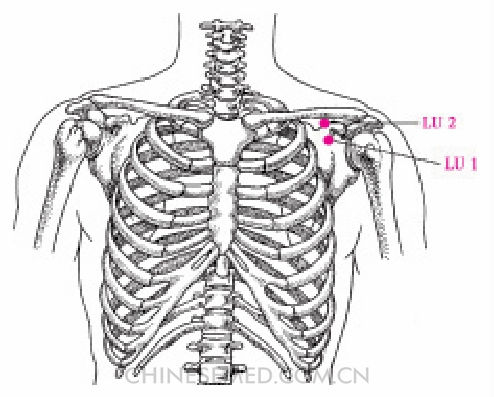
Location method. With the patient sitting upright, locate LU 2 (yún mén) in the depression at the lower border of the lateral aspect of the clavicle. LU 1 is approximately 1 cun below LU 2 and level with the first intercostal space. With the patient supine, the point is directly superior to a point 2 cun lateral to the nipple, in male and in the first intercostal space.
Actions. Regulate lung qi and soothe the chest to relieve pain.
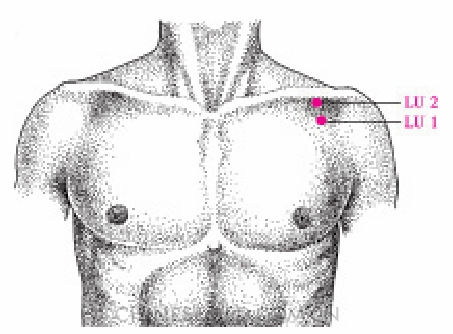
Indications. Lung disorders such as cough, chest pain, asthma; upper back pain.
Manipulation. Acupuncture: 1. Needle perpendicularly 0.3~0.5 cun. 2. Needle obliquely 0.5~0.8 cun toward the lateral side of the chest. Local soreness and distention can radiate to the chest and the upper limb. Moxibustion: Use 3~5 cones of cone moxibustion, or use a moxa stick for 10~20 minutes.
Precautions. Deep perpendicular insertion or oblique insertion toward the medial aspect is prohibited to avoid causing pneumothorax.
Annotation. The point appeared in The Pulse Classic (Mài Jīng, 脉经). Zhōng refers to the middle jiao; fǔ means residence. The point is named for its location on the hand taiyin channel, which begins in the middle jiao, and for its position as the first point of the channel.
LU 2 (Yún Mén, 云门)
Location On the anterior thoracic region in the depression of the infraclavicular fossa, medial to the coracoid process of the scapula and 6 cun lateral to the anterior median line (Pic. 3-1a, Fig. 3-1b).
Location method. With the patient sitting upright or supine, the point is at the midpoint of the triangular depression at the inferior margin of the distal clavicle.
Actions. Purify the lung, regulate qi, and purge limb heat.
Indications. Lung disorders such as cough, chest pain, and asthma; upper back pain.
Manipulation. Acupuncture: Needle obliquely 0.5~1.0 cun toward the lateral side of the chest. Local soreness and distention can radiate to the chest and the axilla. Moxibustion: Use 3~7 cones of cone moxibustion, or use a moxa stick for 5~15 minutes.
Precautions. In perpendicular needling of LU 2, take care not to puncture the axillary vein by inserting the needle obliquely. The cephalic vein can be pierced if the needle is inserted close to the inferior border of the clavicle, and the parietal pleura or even the lung can be punctured in deep needling toward the medial side. Before needling, fnd the pulsating axillary artery with the fngers; press it downward and insert the needle between the medial border of the coracoid process of the scapula and the inferior border of the clavicle with the other hand. It is safe to insert perpendicularly toward the back or slightly toward the lateral side of the chest.
Annotation. The point appeared in Basic Questions-Treatise on Hydrothermal Points (Sù Wèn-Shuĭ Rè Xué Lùn, 素问·水热穴论). Yún means cloud or mist; mén means door or gate. This point got its name because it is a gate where lung qi enters and exits.
LU 3 (Tiān Fŭ, 天府)
Location On the anteromedial aspect of the arm just lateral to the border of the biceps brachii muscle, 3 cun inferior to the anterior axillary fold (Pic. 3-2).
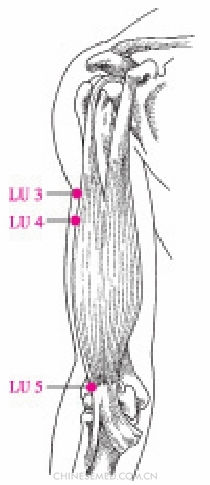
Location method. With the patient’s arm raised perpendicularly forward and the head bent downward, the point is where the tip of the nose touches the upper arm.
Actions. Soothe and regulate lung qi, calm fright, and stop bleeding.
Indications. Lung disorders such as cough, asthma, nosebleed; pain in the upper arm; goiter.
Manipulation. Acupuncture: Needle perpendicularly 0.5~ 1.0 cun. Local soreness and distention can radiate to the arm or the elbow. Moxibustion: Use 3~5 cones of cone moxibustion, or use warming needle moxibustion for 20 minutes, or use a moxa stick for 5~10 minutes.
Annotation. The point appeared in The Spiritual Pivot-Cold
and Febrile Diseases (Líng Shū-Hán Rè Bìng, 灵枢·寒热病). Tiān means sky; fǔ means residence. Anatomically, the lung is the highest of the fve zang-fu organs. The point is named for its location on the upper arm where lung qi gathers.
LU 4 (Xiá Bái, 侠白)
Location On the anteromedial aspect of the arm just lateral to the border of the biceps brachii muscle, 4 cun inferior to the anterior axillary fold (Pic. 3-2).
Actions. Diffuse the lung, regulate qi, soothe chest, and harmonize the stomach.
Indications. Lung disorders such as cough, vexation, fullness, asthma; belching; upper arm pain.
Manipulation. Acupuncture: Needle perpendicularly 0.5~1.0 cun. Local soreness and distention can radiate to the front of the chest or the forearm with electric sensations. Moxibustion: Use 3~5 cones of cone moxibustion, or use warming needle moxibustion for 20 minutes, or use a moxa stick for 5~10 minutes.
Annotation. The point appeared in The Systematic Classic of Acupuncture and Moxibustion (ZhēnJiŭ Jiă Yĭ Jīng, 针灸甲乙经). Xiá means clasping or side in this context; bái means white, the color of the lung. With the arm hanging down, the point is 1 cun below LU 3 (tiān fǔ) on the medial aspect of the upper arm.
LU 5 (Chǐ Zé, 尺泽)
He-sea point
Location On the medial aspect of the elbow at the cubital crease, in the depression lateral to the biceps brachii tendon (Pic. 3-2).
Location method. With the patient’s wrist bent and the elbow fexed slightly, the point is on the radial side of the transverse crease of the elbow and the palmar side of the elbow joint.
Actions. Enrich yin to moisten the lung, relieve cough, and direct counterflowing qi downward.
Indications. Excess heat syndromes of the lung such as cough, coughing up blood, swollen and sore throat, tidal fever, dry tongue, asthma; gastrointestinal problems such as vomiting, diarrhea, and intestinal colic; acute conditions such as acute vomiting, diarrhea, summerheat stroke, infantile convulsion; spasm and pain in the upper arm.
Manipulation. Acupuncture: 1. Needle perpendicularly 0.5~1.0 cun. Local soreness, distention, and electrical sensations can radiate to the forearm or the hand. 2. For acute vomiting and diarrhea, prick to bleed with a three-edged or thick fliform needle. Moxibustion: Use 5~7 cones of cone moxibustion, or use warming needle moxibustion for 20 minutes, or use a moxa stick for 5~10 minutes.
Precautions. 1. Scarring moxibustion is forbidden as a scar can affect the movement of the elbow joint. 2. Do not insert perpendicularly more than 1 cun. Deeper insertion can pierce blood vessels, lead to bleeding, and affect fexion and extension of the arm.
Annotation. The point appeared in The Spiritual Pivot-Fundamental Points (Líng Shū-Bĕn Shū,灵枢·本输). Chǐ means forearm skin; zé is a place where water gathers, such as a pond. In the fve phases, this point belongs to water and is perceived as the place where hand taiyin channel qi arrives and gathers like water gathering in a pond, so it is called chǐ zé.
LU 6 (Kŏng Zuì, 孔最)
Xi-cleft point
Location At the anteromedial aspect of the forearm on the line connecting LU 5 (chĭ zé) with LU 9 (tài yuān), 7 cun superior to the palmar wrist crease (Pic. 3-3).
Actions. Clear heat and resolve toxins, direct counterflowing qi downward, and stop bleeding.
Indications. Lung disorders such as hemoptysis, epistaxis, loss of voice, swollen and sore throat, cough, asthma; febrile diseases without sweating, headache, hemorrhoids; spasm and pain, dysfunction in arm fexion and extension.
Manipulation. Acupuncture: Needle perpendicularly 0.5~0.8 cun. Local soreness, distention, and heaviness can radiate to the forearm. Moxibustion: Use 5~7 cones of cone moxibustion, or use warming needle moxibustion for 20 minutes, or use a moxa stick for 10~20 minutes.
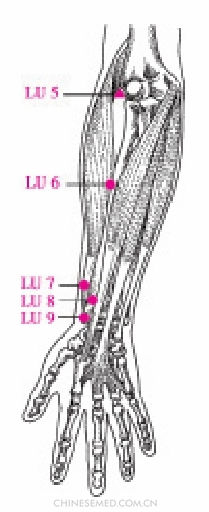
Precautions. Avoid the radial arteries and veins to prevent hemorrhaging.
Annotation. The point appeared in The Systematic Classicof Acupuncture and Moxibustion (Zhēn Jiŭ Jiă Yĭ Jīng, 针灸甲乙经). Kǒng means hole or small opening; zuì means the most or extreme. As the xi-cleft of the hand taiyin channel where qi and blood gather deeply, this is the most effective point for regulating blood and relieving stuffy orifices.
Modern clinical observation and research. In a case series, daily acupuncture and ginger moxibustion were used to treat bronchial asthma. LU 6 (kǒng zuì) was needled until the arrival of qi,withdrawn, and moxa was applied. Ten treatments constituted a course; patients received 1~3 courses. At the two-year follow up, 19 of 100 had recovered (19.0%); 80 improved (80.0%). One case was unsuccessful (1.0%).1
LU 7 (Liè Quē, 列缺)
Luo-connecting point; confuence point of the ren mai
Location On the radial aspect of the forearm between the tendons of the abductor pollicis longus and the extensor pollicis brevis muscles in the groove of the abductor pollicis longus tendon, 1.5 cun superior to the palmar wrist crease (Pic. 3-3).
Location method. With the index fnger of one hand pressing the radial styloid process of the other hand, the point is in the depression where the index fnger tip lies. Alternatively, extend the wrist and locate LI 5 (yáng xī) between the two tendons; LU 7 is in the depression at the middle of the radial styloid process 1.5 cun above LI 5 (Pic. 3-4).
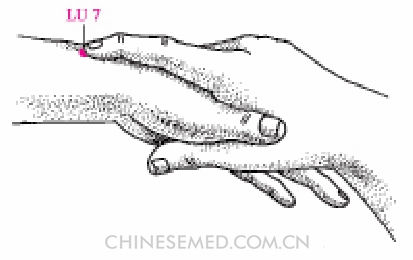
Actions. Dispel wind and disperse pathogens, dredge and regulate ren mai.
Indications. Lung disorders such as cough, shortage of qi for breath and asthma; disorders of the head, neck, and five sensory organs including migraine, stiff neck, deviated mouth and eyes, toothache, sore throat, sinusitis; heat sensation in the palms, motor impairment of the upper extremities, disability of the wrist; fright epilepsy, hematuria, excessive heat in the urine, enuresis, phallodynia, urticaria, Takayasu’s disease.
1 Wang XX. Puncturing LU 6 (kǒng zuì) to treat bronchial asthma针灸孔最穴治疗支气管哮喘. Chinese Acupuncture &Moxibustion. 2009; 29(4): 326.
Manipulation. Acupuncture: 1. Needle obliquely 0.2~0.3 cun upward. Local soreness, distention, and heaviness can induce a radiating sensation to the elbow and the shoulder. 2. Needle obliquely 0.3~0.5 cun downward. 3. Use lateral needling to treat disorders such as stenosing tenosynovitis. Moxibustion: Use 3~5 cones of cone moxibustion, or use a moxa stick for 5~10 minutes.
Precautions. Scarring moxibustion is forbidden.
Annotation. The point appeared in The Spiritual Pivot-Channels (Líng Shū-Jīng Mài, 灵枢·经脉). Liè means a split or fssure. The channel branches into the yangming channel from this point, which is located above the radial styloid process between the brachioradial muscle and the tendon of the long abductor muscle of the thumb where there seems to be a fssure.
LU 8 (Jīng Qú, 经渠)
Jing-river point
Location On the anteromedial aspect of the forearm between the radial styloid process and the radial artery, 1 cun superior to the palmar wrist crease (Pic. 3-3).
Location method. With the patient’s palm fat and facing upwards, the point is 1 cun above the transverse crease of the wrist where the axillary artery pulsates and the middle finger rests when diagnosing the pulse.
Actions. Diffuse the lung and relieve panting, soothe the chest, and regulate qi.
Indications. Lung disorders such as cough, chest pain, asthma; wrist pain.
Manipulation. Acupuncture: 1. Needle perpendicularly 0.1~0.3 cun; local soreness and distention will be felt and can radiate to the forearm. Moxibustion: Use 3~5 cones of cone moxibustion, or use warming needle moxibustion for 20 minutes, or use a moxa stick for 10~20 minutes. Scarring moxibustion is forbidden as the point is close to the radial artery.
Precautions. When needling, avoid damaging the vessels by using the fingers of one hand to press the radial artery and vein slightly inward while the other hand inserts the needle at the medial aspect of the radial styloid process.
Annotation. The point appeared in The Spiritual Pivot-Fundamental Points (Líng Shū-Bĕn Shū,灵枢·本输). Jīng means to move; qú means channel. This point, between the medial side of the radial styloid process and the radial artery, is in a long depression shaped like a channel carrying water, so it was named jīng qú.
LU 9 (Tài Yuān, 太渊)
Shu-stream point; yuan-source point; influential point of the vessels
Location On the anteromedial aspect of the wrist between the radial styloid process and the scaphoid in the depression ulnar to the abductor pollicis longus tendon (Pic. 3-3).
Actions. Relieve cough and dissolve phlegm, unblock and regulate the blood vessels, fortify the spleen and boost qi.
Indications. Lung disorders such as cough and asthma; Takayasu’s disease; wrist pain.
Manipulation. Acupuncture: Needle perpendicularly 0.2~0.3 cun to produce local numbness and distention. Moxibustion: Use 1~3 cones of cone moxibustion, or use a moxa stick for 5~10 minutes. Scarring moxibustion is forbidden as the point is near the radial artery.
Precautions. Avoid the radial artery when needling this point. One fnger can be used to press the vessel slightly toward the radial side while the other hand inserts the needle along the radial side of the tendon of fexor carpi radialis.
Annotation. The point appeared in The Spiritual Pivot-Fundamental Points (Líng Shū-BĕnShū, 灵枢·本输). Tài means big; yuān means deep. This point got its name because it is the major meeting point where channel qi gathers.
Modern clinical observation and research. In a case series, LU 9 (tài yuān) was used to treat primary hypertension (n=68). Needles were inserted perpendicularly 5~8 mm and retained for 30 minutes without manipulation while blood pressure was measured on the other arm. Blood pressure returned to normal within 30 minutes in 16 cases (23.5%); 30~59 minutes (54.4%) in 37; 60 minutes in 14 (20.6%). One case was unsuccessful (1.5%).1
LU 10 (Yú Jì, 鱼际)
Ying-spring point
Location On the palm, radial to the midpoint of the first metacarpal bone at the border between the red and white fesh (Pic. 3-5).
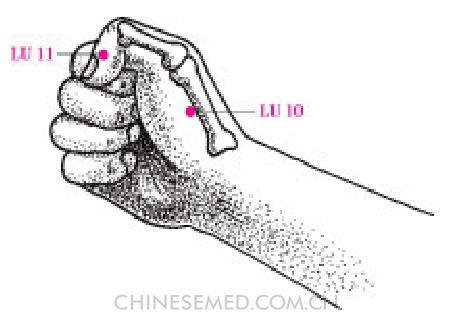
Actions. Disperse wind and clear heat, diffuse the lung and soothe the throat.
Indications. Lung febrile diseases such as cough, hemoptysis, loss of voice, pharyngitis, dry throat; infantile malnutrition.
Manipulation. Acupuncture: 1. Needle perpendicularly 0.3~0.5 cun; local soreness and distention can radiate to the thumb. 2. Bleed with a three-edged needle or the piercing method. Moxibustion: Use 3~5 cones of cone moxibustion, or use a moxa stick for 3~5 minutes.
Precautions. Scarring moxibustion is forbidden.
Annotation. The point appeared in The Spiritual Pivot-Fundamental Points (Líng Shū-Bĕn Shū,灵枢·本输). Yú means fsh; jì means border. This point is at the edge of the abductor pollicis brevis and the opponens pollicis muscles where the muscles protrude to resemble a fsh belly.
LU 11 (Shào Shāng, 少商)
Jing-well point
Location On the thumb radial to the distal phalanx, 0.1 cun proximal-lateral to the radial corner at the intersection of a line along the radial border and one along the base of the thumb nail (Pic. 3-5).
Location method. Place the palm sideways and clench the fist slightly; extend the thumb upward and draw a line along the radial border and another along the base of the nail. The point lies at the intersection of the two lines.
Actions. Clear heat to release the exterior, soothe the throat, and open the orifices to resuscitate.
Indications. Lung febrile diseases such as cough, swollen and sore throat, nosebleed, asthma; wind-stroke, unconsciousness, psychosis, infantile convulsions; numbness of fnger and wrist.
Manipulation. Acupuncture: 1. Needle superficially 0.1~0.2 cun to produce local soreness and distention. 2. Bleed with a three-edged needle. Before needling, push the blood to the fnger tip, hold tightly, and insert the needle into the point rapidly to expel 5~10 drops of blood. Moxibustion: Use 3~5 cones of wheat-grain sized moxibustion, or use a moxa stick for 5~10 minutes.
Precautions. Scarring moxibustion is forbidden. This point is strongly stimulating; use caution when needling pregnant patients.
Annotation. The point appeared in The Spiritual Pivot-Fundamental Points (Líng Shū-Bĕn Shū,灵枢·本输). Shào means little; shāng is the lung tone, one of the fve tones in fve element theory. This point is where lung channel qi originates. When the channel qi begins, it is small like a stream, giving the point its name, shào shāng.

